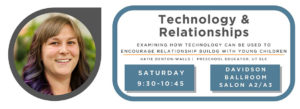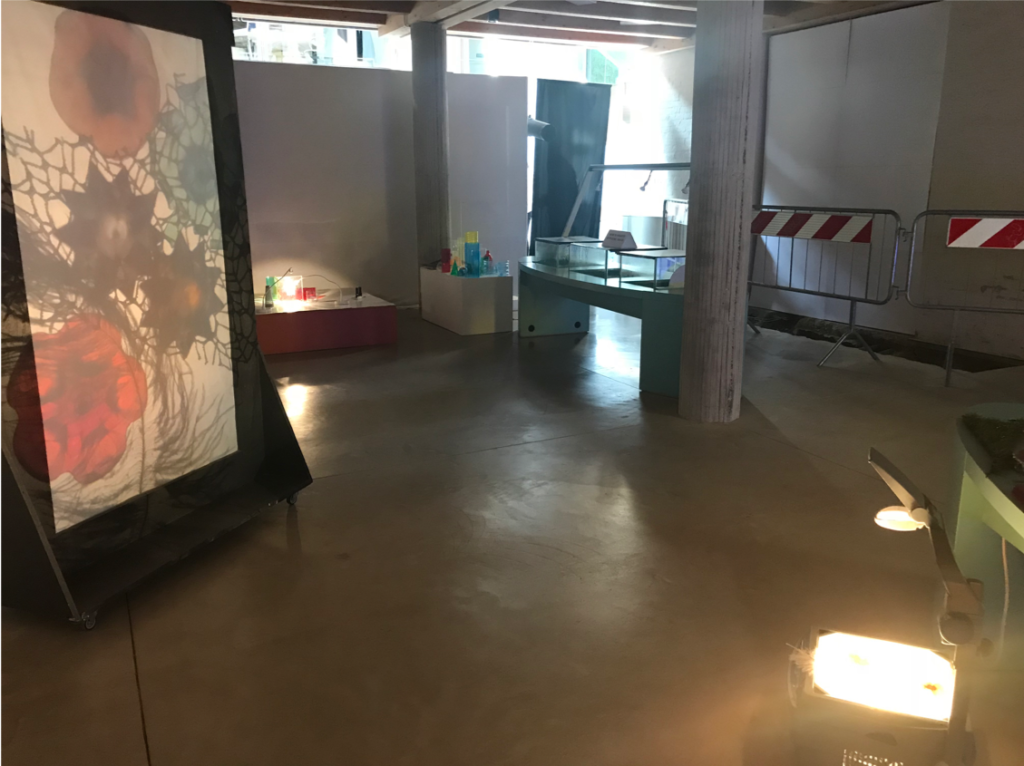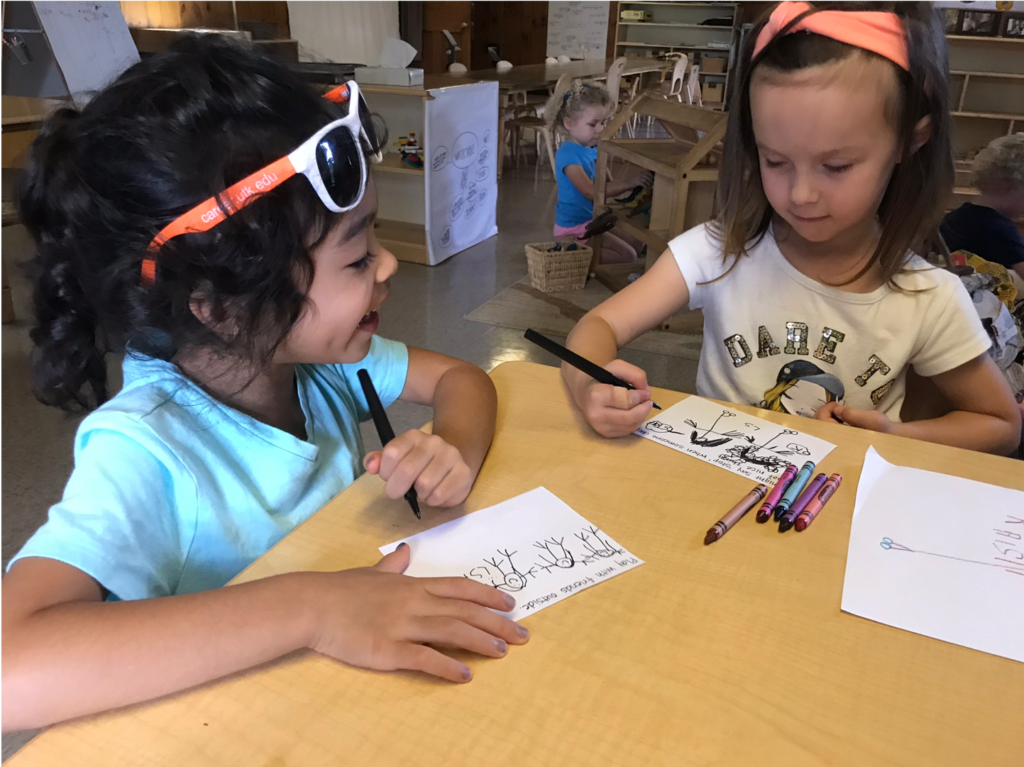This piece was authored by preschool Demonstration Teacher Katie Denton-Walls for a presentation at the NAEYC national conference in November 2019.

When I first started teaching in 2010, I had a computer in my classroom. The computer was set up for the children to use to play some educational games, and it was an area of the classroom that was coveted; every child wanted their time on the computer. After a few months, I started to notice a troubling pattern. After children left the computer they would often have a hard time engaging in play. It was like they were waiting for something to magically happen to capture their interest, much like what happens on the computer. Has anyone else noticed this?
After I started to notice this pattern, it was all I could see and I decided to take the computer out of the classroom. In my particular context I knew that the children had access to computers at home, and reasoned that what they needed to learn at school was how to interact with one another meaningfully and cooperatively. The computer wasn’t helping that happen. For several years I did not have much technology in the classroom. I would bring in a laptop if the children needed to research something or use my phone to record videos and take photos that I would share with the children, but it wasn’t a part of our daily classroom life. As time went on I began to notice a bigger push toward using technology in education; elementary schools were giving children laptops and iPads to use. As a school, we started discussing what our responsibility was in educating children about using technology, and whether or not we could do that and still hold true to our values. As these discussions continued I found myself grappling with four big questions about bringing technology back into the classroom.
First, how much is too much? According to the American Academy of Pediatrics, screen time for children in my age group should be limited to 1 hour per day of high-quality programs, and the concerns about having too much screen time include that children then don’t have enough time to play. This led me to my next question; does the way in which the technology is used alter the answer to the first question? I started thinking that if children are using technology actively, to create or engage, rather than passively as when watching a show, does that alleviate some of the concern? Third, I had to ask myself what is my responsibility in terms of preparing children for their later experiences? Am I over-looking a necessary component of early childhood education by using technology in such a limited manner? Could multi-modal learning needs be met more effectively? These questions led me to my final question- the one that I decided was the most important in making decisions about using technology with young children; are there ways children can use technology that supports my overall values of community, inquiry, and exploration?
I decided that I had to start by getting to know the tools that I could offer to children; iPads, laptops, cameras, and projectors. I spent time playing with these tools, learning how they work and considering how they could be used by and with children to support learning and relationships. I also engaged in discussions with others at my school to help me consider what I felt comfortable with giving to the children to use or using with the children, and what I expected the impact to be of using these tools with the children. Just like when planning for anything with children, I needed to know what I wanted to come from it while also being ok with the fact that it might not turn out as planned.
I read all the time and I like to study things before I do them. I started doing research about how others were using technology with young children and what the effects were. In a study by Tavenier & Hu (2017), children used creation-based apps to take photos, compose drawings, and record audio. The researchers found that the children demonstrated feelings of pride when what they created was able to be shared with others. I found this encouraging because it showed support for the opposite of what I had seen in my classroom; technology supporting interaction. Parette, Quesenberry, and Blum (2010) argue that digital literacy skills are necessary for children to develop, and it can be construed as unresponsive to ignore this aspect of children’s cultural context. Ignoring technology is exactly what I had been doing for several years. In another study, Marsh found that certain types of technology and allow children to engage in role-play, interaction, verbal communication, and games with rules. These types of technology offer children the opportunity to play at being different characters who all have different roles and opportunities, much like typical dramatic play. While I would not want this to be the only way children have to engage in this type of play, I could see how offering an additional opportunity would be valuable. The last study that I want to share with you was conducted by Burke and focused on how technology can support identity development. Burke found that certain games and uses of technology allow for children to make meaning by re-enacting scenarios and exploring roles, and creating socio-emotional connections with others as they use technologies together.
I mentioned earlier that the early childhood programs in Reggio Emilia have served as an inspiration for me, and in 2018 I had the amazing opportunity to visit the schools myself. I took so much away from this experience, but for the purpose of this presentation, I wanted to share with you a couple of ways I saw technology being used with children in the Digital Landscapes Atelier at Loris Malaguzzi International Center. In the photo to  the right, we see an overhead projector being used with a simple white screen. Translucent and transparent materials were available for children to place on the projector, altering the image projected onto the screen. This was a collaborative experience, where many could participate. This is simple technology, but being used in this way makes it really exciting.
the right, we see an overhead projector being used with a simple white screen. Translucent and transparent materials were available for children to place on the projector, altering the image projected onto the screen. This was a collaborative experience, where many could participate. This is simple technology, but being used in this way makes it really exciting.
At another part of the atelier, I saw this setup in the photo to the left. Now, to me, this was intimidating- lots of parts and wires… but once I really looked at it, I realized that it was really just a small lamp, a webcam, and a computer being used in a pretty similar way as the overhead projector. Seeing these examples of technology being set up for and used with young children in such a different way, a way that wasn’t sitting in front of a screen and playing a game, made my own hopes for using technology seem more attainable.
this setup in the photo to the left. Now, to me, this was intimidating- lots of parts and wires… but once I really looked at it, I realized that it was really just a small lamp, a webcam, and a computer being used in a pretty similar way as the overhead projector. Seeing these examples of technology being set up for and used with young children in such a different way, a way that wasn’t sitting in front of a screen and playing a game, made my own hopes for using technology seem more attainable.
I also want to share something from a school that I find inspiring that’s a little closer to home; Boulder Journey School in Boulder, CO. They derive inspiration from the work of the teachers in Reggio Emilia and Frances and David Hawkins. If you don’t know about Francis and David Hawkins, I would definitely suggest looking them up- they did a lot of meaningful work in our field. At Boulder Journey School they have a strong focus on connection, and they have found ways to use technology to support this goal. You can see here that these children are using a cell phone on a tripod and a projector to be able to see and interact with themselves and each other in a different way.
I decided that however I brought technology into the classroom, I wanted to achieve three goals that supported my values. First, I wanted to find a way to integrate technology that supported the project work happening in the classroom. Second, I wanted to be sure that the children had time to play with the technology- to really build a relationship with it, to understand how it works so that they could use it in the most meaningful way. Last, I wanted to use technology to strengthen the home-school connections for the children and families. I’m going to share a little with you about each of these.
Connection to Project Work
 In the fall of 2018, my classroom began working on agreements. In our classroom, agreements are the expectations the children set for themselves and each other so that they feel cared for and safe at school. For example, the children made an agreement that said ‘play with friends outside,’ which you can see Samaya illustrating in this picture. I wanted to find a way to use technology to support the children’s exploration of their agreements in order to provide multimodal experiences because up to this point the children had mostly engaged with their agreements through conversation and drawing. I brought a small group of children together, presented them with one of their agreements, and asked them how they could act it out. In the video below, the children are acting out the agreement they made that states ‘if you knock over someone’s structure build it back.’ The children watched the video after they finished, and decided that they liked it and that it represented their agreement well.
In the fall of 2018, my classroom began working on agreements. In our classroom, agreements are the expectations the children set for themselves and each other so that they feel cared for and safe at school. For example, the children made an agreement that said ‘play with friends outside,’ which you can see Samaya illustrating in this picture. I wanted to find a way to use technology to support the children’s exploration of their agreements in order to provide multimodal experiences because up to this point the children had mostly engaged with their agreements through conversation and drawing. I brought a small group of children together, presented them with one of their agreements, and asked them how they could act it out. In the video below, the children are acting out the agreement they made that states ‘if you knock over someone’s structure build it back.’ The children watched the video after they finished, and decided that they liked it and that it represented their agreement well.
Next, I added the video to the iPad and pulled still photos from it to create a book. I wanted to be sure the children had different ways to interact with their agreements. Adding the videos the children made soon evolved into adding videos from spontaneous moments during the daily life of our classroom.
 As they watched the videos, the children discussed their actions- how they affected others, what they could do differently, and how they felt in that moment or would feel if they were involved. Having the videos available for the children to review together, in their own time, created a safe space to discuss challenging issues and emotions as many of the videos focused on their agreements dealt with times children felt sad or angry.
As they watched the videos, the children discussed their actions- how they affected others, what they could do differently, and how they felt in that moment or would feel if they were involved. Having the videos available for the children to review together, in their own time, created a safe space to discuss challenging issues and emotions as many of the videos focused on their agreements dealt with times children felt sad or angry.
Playing with Technology
Children learn through play- it is an avenue by which they explore their understandings of their world and bond with one another. Having the videos on the iPad had offered the children many opportunities, but we wanted to find a way to use technology to help them play with other ideas and tools while building relationships. So, we decided to bring in two new tools; an overhead projector and a digital projector that the iPad could be connected to.
In the video linked here, Max and Luke are working with the overhead projector and a variety of materials. They work together cohesively and seem to have a shared plan or vision for what they are creating. At one point Luke is dancing in front of the projection, and Max initially tells him to stop, but then moves into the same space and begins moving in a similar way. This use of the projector has provided a point of connection for these two children as they work together and experiment with different ways of interacting with the technology and each other.
Next, I want to share a video of Jessie and Aadi use the projector with the iPad to play with a caterpillar. We see Jessie and Aadi building a relationship with each other as they play together; they are taking turns and enjoying their time together in this shared interest. In addition, they are forming a relationship with the caterpillar as they watch how it moves and play with the idea of it being on their bodies in a safe way through the projected image.

I also decided to use the technology to bring the children’s play and project work together by making the agreement videos available on the iPad when it was hooked up to the projector. This allowed the children to explore the same videos in a new and more playful way than they did when the watched them on the smaller iPad screen.
Family Connections
My co-teacher and I have been working for the last year a half to consider the many ways we can work to strengthen the home-school connection for our children in families. For example, we have asked our families to send us music that is important to their family in some way; favorite songs, cultural representations, and anything else they want to share. We then added this music to our playlist, and play it throughout the day as the children work and play.
The children had become very comfortable using the iPad at this point, so we wanted to use that as a way to bring our families into the classroom in another way. To do this, we asked each family to take a video of them reading a children’s book. We specified that we would like to use this as a way to strengthen the home-school connection, while also supporting another goal we were working toward; exposing the children to diverse cultures, so we asked families to read in their home language if they were comfortable doing that. Here, we have Mahin and her dad reading a book in Vietnamese.
Once a family completed their video, I added it to our iPad and the children had it available throughout the day. Here, you will see Henry and Amelia watching as Henry’s mom reads The Giving Tree by Shel Silverstein.
There are two things that stand out to me in this video; the children’s concentration and Henry’s smile. I believe that Henry is focused because he is watching his mom read to him, and I believe Amelia is just as focused because her relationship with Henry helps her to feel a connection to Henry’s mom. Maybe I’m wrong, but every day I see children going up to one another to share that they just watched the video of their friend’s mom or dad reading and I see the joy on both children’s faces.
Next Steps
So, this is where I am right now in my practice using technology in a way that supports my values and children’s relationships. I think that so far this journey, while challenging, has proven to be an important and meaningful one for both me and the children. We’ve learned a lot, and I see the children using technology as a way to interact with one another every day. I have a few new goals as I continue with this work; bringing technology into other areas of the classroom and experimenting with different technological tools. All of this work presents some logistical challenges, and right now as I consider the new goals I am most concerned with what in the world to do with all the cords and how to make sure the equipment is protected. I plan to keep testing out new methods and hopefully find one that works.
Professional Development at the ELC
For more information about professional development opportunities at the ELC, visit our Study Tours page and check our Early Learning Institute page for details about our yearly summer conference here in Knoxville, TN!